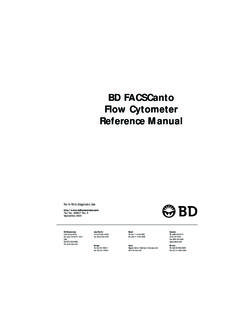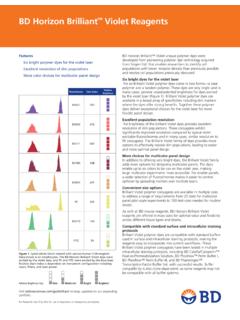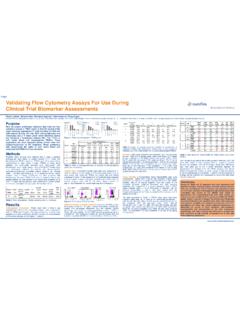Transcription of Combination Immune Checkpoint Inhibitors for the …
1 Combination Immune Checkpoint Inhibitors for the Treatment of Human Colon Carcinoma in NSG Mice Engrafted with Human PBMC. Martin R. Graf; Jason M. Davis; Anya Avrutskaya; Lynnelle Thorpe; Mark Ellison; Vivek Mahajan; Thi Bui; Aidan Synnott; Robert J. Mullin and Paula L. Miliani de Marval. Charles River Discovery Services, Morrisville, NC, USA 4 SUMMARY and CONCLUSIONS 2 MATERIALS AND METHODS PK and Efficacy studies: Female NSGTM mice (Jackson laboratory), were 8-10 weeks were engrafted with human peripheral blood mononuclear cells (PBMC) at 3x107 cell/animal (Hemacare; PBMC-HLA-A*01/01, PBMC-HLA-A*01/02; PBMC- HLA- A*03/24).
2 Seven days post engraftment, animals were implanted with 5x106 RKO tumor cells in 50% Matrigel, subcutaneously in the right flank. Dosing began on Day 1 in mice with established RKO tumors (group mean 70 mm3). The study endpoint was a tumor volume of 1500 mm3 in the control group for the RKO I study and Day 18 in the RKO II study in which samples were collected for flow cytometry analysis. Treatment outcome was based on percent tumor growth inhibition (%TGI), defined as the percent difference between the median tumor volumes (MTVs) of treated and control mice.
3 Percent TGI was calculated using the following formula: %TGI = [1 -(MTVdrug treated/MTVcontrol)] x 100. The results of two independent studies are shown here. Statistical Significance was determined using the Mann-Whitney U test. Flow Cytometry Analysis Peripheral blood was collected in tubes containing K2 EDTA and Immune cell populations were analyzed by flow cytometry. All data were collected on a FACSC anto II (BD) and analyzed with FlowJo software (Tree Star, Inc.). Initial sequential gating on singlets (FSC-H vs.)
4 FSCA), leukocytes (SSC-A vs. FSC-A) and live cells was performed followed by identification of Immune cells populations based upon the following phenotype markers: hCD45+; CD4 (hCD45+CD3+CD4+), CD8 (hCD45+CD3+CD8+), T cell populations were further defined as effector (EFF) and effector memory (EM) based upon CCR7 and CD45RO expression. The cell lines A375, A2058, SK-MEL-24, SK-MEL-5, HT-1080, Colo205, RKO, HCT116, MDA-MB-231, Calu6, HCC827, SKOV3, were analyzed by flow cytometry for the expression of PD-L 1 and PDL-2.
5 1 ABSTRACT Over the past decade there has been an increasing interest for preclinical models useful for evaluating the efficacy of Checkpoint inhibition-based cancer immunotherapies. Moreover, the recently developed humanized mouse models offer a unique tool to evaluate the anti-tumor response of the human Immune system to Checkpoint Inhibitors . In a model development study we established that animals successfully engrafted with huPBMC developed graft versus host disease (GvHD) in 5 to 6 weeks. Here we present the response to the Checkpoint Inhibitors pembrolizumab (anti-PD-1 ) and ipilimumab (anti-CTLA-4 ) in the human RKO colon carcinoma (HLA-A* 01) xenograft model following the engraftment of HLA matched huPBMC in NSG mice.
6 Combination of pembrolizumab with ipilimumab therapy resulted in a significant inhibition of tumor growth. Analysis of the human Immune cell subsets showed the major fraction of the human CD45 cells were T-cells. There was a significant increase in the T-cell population of the Combination treatment group as compared to the control group in which CD8 T-cells predominated. In summary, this study supports the use of huPBMC-NSG mouse model to test the tumor response to Immune - Checkpoint based therapies as it shows significant tumor growth inhibition associated with CD8 T expansion.
7 In addition, this study demonstrates that there is a therapeutic window to evaluate cancer treatments before the onset of xenogeneic GvHD in this model. 3 RESULTS 5 ACKNOWLEDGEMENTS # 161 Cell line % PD-L1 + % PD-L2 + A375 melanoma HT-1080 fibrosarcoma SK-MEL-5 melanoma HCC827 lung Colo205 colon SK-MEL-24 melanoma RKO colon MDA-MB-231 breast HCT116 colon Calu6 lung SKOV3 ovarian A2058 melanoma Table I: Evaluation of the Expression of PD-L1, PD-L2, In Human Cell Lines by Flow Cytometry Analysis Figure 1: Evaluation of multiple hPBMC donors for engraftment levels in NSG mice.
8 Group n Regimen 1 Donor Cell # Injection Site Schedule 1 4 PBMC Donor 1 A*01/01 3 x 107 iv day 1 2 4 PBMC Donor 2 A*01/02 3 x 107 iv day 1 3 4 PBMC Donor 3 A*01/02 3 x 107 iv day 1 4 4 PBMC Donor 4 A*03/24 3 x 107 iv day 1 Treatment Regimen MTV (n) Statistical Significance Group n PBMC: A*01/01 Agent g/animal Route Schedule Day 18 %TGI vs G1 vs G4 1 5 3 x 107 Polyclonal Human IgG 200 ip biwk x 3 936 (5) --- --- --- 2 6 3 x 107 ipilimumab 100 ip biwk x 3 600 (6) 36 p< p< 3 5 3 x 107 pembrolizumab 100 ip biwk x 3 320 (5) 66 p< ns 4 6 3 x 107 ipilimumab pembrolizumab 100 100 ip ip biwk x 3 320 (6) 66 p< --- Treatment Regimen Group n PBMC.
9 A*01/01 Agent g/animal Route Schedule 1 8 3 x 107 Polyclonal Human IgG 200 ip biwk x 3 2 8 3 x 107 Ipilimumab (anti-hCTLA-4) pembrolizumab (anti-hPD-1) 100 100 ip ip biwk x 3 d18 d15 Tx Tx -12d d4 d11 d8 d1 -5d HuPBMC 50-80mg Tumors Start Tx Tx Tx Tx Tumor implant d13 d27 End Treatment Regimen MTV (n) Statistical Group n PBMC Agent g/animal Route Schedule Day 37 %TGI Significance 1 7 No Polyclonal Human IgG 100 ip biwk x 3 1639 (7) --- --- 2 7 No ipilimumab 100 ip biwk x 3 1711 (7) -4 ns 3 7 No pembrolizumab 100 ip biwk x 3 2168 (7) -32 p< 4 7 No ipilimumab pembrolizumab 100 100 ip ip biwk x 3 2013 (7)
10 -23 ns Control IgG Ipi Pembro Pembro +Ipi Treatment Table for PK study Mean Body Weight of Engrafted NSG Mice Identification of Immune Cell Subsets from Blood Samples Collected on Days 8 and 22 from NSG Humanized Mice Representative Immune Cell profile of hPBMC Prior to Engraftment hCD45% hCD3% hCD4% hCD8% Day 8 Day 22 Day 8 Day 22 Day 22 Day 22 Day 8 Day 22 PBMC Donor 1 A*01/01 ND ND ND ND PBMC Donor 2 A*01/02 PBMC Donor 3 A*01/02 PBMC Donor 4 A*03/24 Figure 2: Evaluation of the Efficacy of Ipililumab (anti-hCTLA-4) and Pembrolizumab (anti-hPD-1) Combination Therapy in the Human RKO Colorectal Carcinoma in Humanized NSG Mice.







